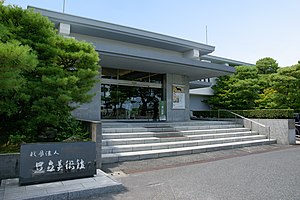Adachi Art Museum
 Entrance to the museum |
|
| Data | |
|---|---|
| place | Yasugi , Shimane Prefecture , Japan |
| Art |
Private art museum
|
| opening | 1970 |
| operator |
Adachi Zenkō (founder)
|
| Website | |
The Adachi Art Museum ( Japanese 足 立 美術館 , Adachi Bijutsukan ) is a private museum on the outskirts of Yasugi City , Shimane Prefecture, with a focus on contemporary art. It is surrounded by an extensive Japanese garden.
The collection
The museum was built in 1970 by the entrepreneur Adachi Zenkō ( 足 立 全 康 ; 1899-1990) in the area from which he came. His collection focuses on painting of the Nihonga direction, with both the school around Okakura Tenshin and the Kyōto school being represented with important works. Among other things, the acquisition of the collection of Kitazawa Toshio (1917–1997) contributed to the museum's holdings. He even dedicated his own building to Yokoyama Taikan , whose paintings Adachi came into contact with in Osaka in 1948 and who fascinated him throughout his life. He also has works by Takeuchi Seihō (1864–1942), Kawai Gyokudō (1873–1957), Matsumura Shōen (1875–1949), Hashimoto Kansetsu (1883–1945), Murakami Kagaku (1888–1939), Hayami Gyoshū (1894) –1935), Itō Shinsui (1898–1972), and other painters. There are also ink drawings by the last painter in the nanga style Tomioka Tessai , pictures for children by Suzuki Toshio and wooden sculptures by Hirakushi Denchū (1872–1979). Munakata Shikō is represented with his series of the "Ten Great Disciples of Shaka" ( 釈 迦 十大 弟子 , Shaka jū daideshi ).
The ceramic collection, which is also dedicated to a separate building, contains valuable pieces by Kitaōji Rosanjin (1893–1959), Kawai Kanjirō (1890–1966) and others. a.
The garden
The museum is surrounded by a wide Japanese garden (approx. 42,000 m²), which classically includes the heights in the background as a “borrowed landscape”. The merging of different garden types into one overall experience is very modern. You can find the changing garden , but then also a very large gravel garden ( Kare-san-sui ), carefully cut bushes next to natural green. Boulders belong to the garden, even a high waterfall is visible on the edge. The garden and the museum are related to one another. There are carefully planned narrow windows in the museum building, the view of which gives a picture like on a hanging roll or cross roll.
The tea house in the garden is a copy of the Shōkin-tei ( 松 琴 亭 ) tea house built by Kobori Enshū (1579–1647) in the Katsura villa and has been named Juryū by the 15th master of the Ura-Senke school, Sen Hansō Sōshitsu -an ( 寿 立 庵 ). It is a place of silence in the otherwise busy garden.
Museum literature
- Leaflet to the museum.
- Leaflet to the garden.
- Adachi bijutsukan. Nihon teien to kindai bijutsu. 213 p. 1992.
Web links
Coordinates: 35 ° 22 ′ 48 ″ N , 133 ° 11 ′ 39 ″ E


